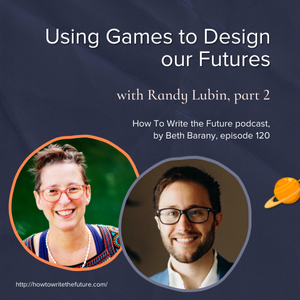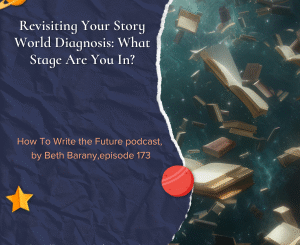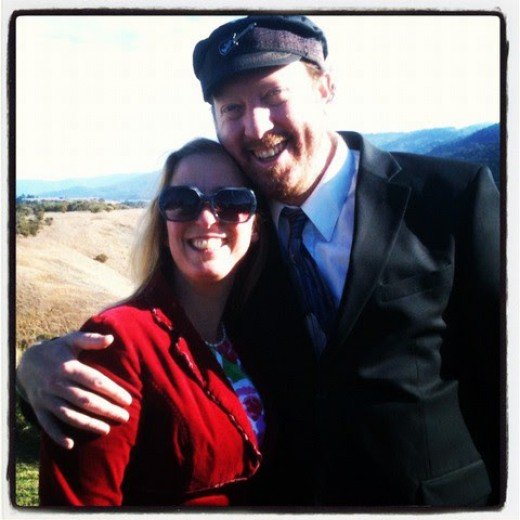Using Games to Design our Futures with Randy Lubin, part 2
Using Games to Design our Futures with Randy Lubin, part 2 – How To Write the Future podcast episode 120
“I know for me what I’m working on, especially at the beginning of creating a story I’m asking, because stories have to have escalating conflict, I ask: What is the worst thing that could happen now to my dear lovely character? And now what?What’s worse than that? And what’s worse than that? And that’s how I build my plot.”
— Beth Barany
In this episode of How To Write the Future podcast, host Beth Barany continues her interview with game designer and entrepreneur, Randy Lubin. They share resources for world-building, discuss the difference between “diegetic” and “diegesis”. Plus Randy shares tips on designing games.
Listen to part 1 where they discuss how games can be used as powerful tools for shaping the future.
Platforms The podcast is available on Apple Podcasts | Buzzsprout | Spotify | Podcast Addict | Amazon Music | Youtube
RESOURCES
Interview Part 1:
Randy Lubin’s game: Premise: Setting, Character, Plot: https://randylubin.itch.io/premise-setting-character-plot
Dialect by Thorny Games: https://thornygames.com/pages/dialect
You’re Gonna Need a Bigger Story: https://www.superstory.works/ourbooks
School of International Futures (SOIF): https://soif.org.uk/retreat/soif-summer-foresight-retreat/
Association of Professional Futurists latest COMPASS magazine: https://www.apf.org/apf-resources/compass
Get your free World Building Workbook for Fiction Writers: https://writersfunzone.com/blog/world-building-resources/
Henrietta The Dragon Slayer, A short film (We’re in post-production and fundraising!) https://author.bethbarany.com/henrietta-short-film/
About the How To Write the Future podcast
The *How To Write The Future* podcast is for science fiction and fantasy writers who want to write positive futures and successfully bring those stories out into the marketplace. Hosted by Beth Barany, science fiction novelist and creativity coach for writers. We cover tips for fiction writers. This podcast is for readers too if you’re at all curious about the future of humanity.
This podcast is for you if you have questions like:
– How do I create a believable world for my science fiction story?
– How do I figure out what’s not working if my story feels flat?
– How do I make my story more interesting and alive?
This podcast is for readers too if you’re at all curious about the future of humanity.
ABOUT RANDY LUBIN
Randy Lubin is a game designer and entrepreneur. He makes foresight games that help organizations explore the future via his studio Leveraged Play. He also makes lighter consumer storytelling games through Diegetic Games.
Website: https://randylubin.com/
X: https://twitter.com/randylubin
LI: https://www.linkedin.com/in/randylubin/
Foresight games studio: https://leveragedplay.com/ Consumer storytelling games: https://diegeticgames.com/ Blog post on integrating foresight games into creative writing:
https://blog.randylubin.com/foresight-workshop-games-creative-writing
Transcript for Using Games to Design our Futures with Randy Lubin, part 2
BETH BARANY: Hey everyone. Welcome back to How To Write the Future Podcast. I’m your host, Beth Barany. I am a creativity coach for writers, science fiction and fantasy writer, writing teacher, and filmmaker. Woo-hoo. More about that later.
[00:13] Part 2 Introduction
BETH BARANY: In part two of my conversation with game designer, Randy Lubin, we talk about the importance of world-building and using games to shape optimistic futures. We also mentioned the concept of trailheads and the book, You’re Gonna Need a Bigger Story to help you develop your expansive story universes. And Randy shares tips on designing games, including remixing existing games and how you can create positive scenarios using game frameworks. We also talk about using creative writing techniques in game design to create rich story driven experiences. Enjoy.
[00:57] More Resources for World Building: World Building Workbook for Fiction Writers
BETH BARANY: People love having these rubrics and starting places.
I love what you called them trailheads. That’s so great. And I’ll just throw out there, share with you, but also our listeners, that I have a World Building Workbook for Fiction Writers that lists all these different areas of the world. And I’ve been starting to realize that, I could have like part two, part three.
So part two, I’ve already been daydreaming about.It’ll be a deeper dive into philosophy, religions, and that kind of thing, worldview. And then, book three or another addendum, or however it comes out would be games, activation games, trailheads, as you say, to give people like, here’s a way to expand this.
[01:35] About the book, You’re Gonna Need a Bigger Story
BETH BARANY: And another resource for folks is the book, You’re Gonna Need a Bigger Story.
Have you seen that?
RANDY LUBIN: I haven’t. Tell me about it.
BETH BARANY: I think you would love it. It’s an offshoot of Jaws. You’re gonna need a bigger boat, right?
So this is called, You’re Gonna Need a Bigger Story. And it comes out of these people who help, people create films. Think of Star Wars is a great example. Lucas, he didn’t just have one story. He had what? Seven stories, nine stories? He started with this huge world and then he said I’ll tell this story. It’s a way of mapping out your story world and also coming up with your mission, like what drives you as a creative to tell this huge story. And then working out the milestones and picking which stories are you gonna tell, and then thinking about, oh, this isn’t, maybe, a novel or a movie.
This is a comic book or this is a song, or this is a game. So thinking about the minor stories, the things that can be told in other mediums.
Especially for science fiction and fantasy writers, it just opens up the story universe. And I’ve seen writers just light up when they read this book because it helps them realize that it’s not just one story they’re telling, that they’re in love with the whole story universe they’re creating.
And it’s so helpful and it’s helped me all kinds of things. I already was doing that, but it also just helped me think so much broader.
RANDY LUBIN: I love that. I’ll definitely have to check that out.
And I love how, by, by going big then even when you have the smaller story set within it, I’m almost certain that it’ll always feel like it’s part of a bigger world, a more cohesive world than it might have otherwise.
[3:08] “Paper Diegesis” “Diegetic” “Hyper Diegesis”
RANDY LUBIN: There’s a term I love called, “paper diegesis.” Is this a term you’re familiar, you’ve come across?
BETH BARANY: I’ve heard diegesis. Isn’t that how things came to be?
RANDY LUBIN: Diegetic, at least, and diegesis
From what I’m familiar with, I think it’s used in different ways, in different contexts, but what I’m familiar with is something is diegetic if it’s happening within the story.
So if you’re watching a movie and, characters walking on the street and there’s sound coming outta the boombox, and you, the audience are hearing the music, but you’re hearing it from the boombox that’s diegetic versus something that’s non diegetic would be like the, just the music’s playing is on the soundtrack, but none of the characters hear it.
Hyper diegesis is a term that refers to everything that is happening in universe that you’re not seeing on the screen or on the page, but is implied or inferred or just generative in that, players are connecting, you know, not should I say players because I’m thinking from a game context. The audience is, connecting the dots.
Like there’s a classic example of this captured on film would be in the movie Clerks where they’re talking about are there independent contractors on the Death Star? And, should we feel bad that they’re gonna get killed when the Death Star gets blown up?
There’s nothing in the text of Star Wars that’s talking about the contractors, but because there’s such rich world building, you could naturally start thinking about- hold on a second. A really big space station. Clearly they couldn’t have built it without contractors.
And so anyway, I love thinking through from both like a game design standpoint and from authoring, like how do you build something that feels one: cohesive and: has enough little, again, trailheads, little terms, phrases, organizations that you maybe only see a little bit of but are very generative in, in an audience’s mind of oh, what? What does that imply?
BETH BARANY: Exactly. Yeah. That’s so great. And there’s a really great example from the Star Wars universe where I believe in book one or maybe book, not book one in the original Star Wars movie, or maybe an Empire Strikes Back, there’s a mention, one mention of the Clone Wars. One person says one sentence about the Clone Wars, and then now, and then look what they did. They created a whole series and it’s got all these characters.
So for the most Part, Star Wars, George Lucas and the other story developers, have done this great job of taking all these offshoot stories and creating whole universes around them. And so this is something that I worked on very heavily actually with my young adult Adventure fantasy, Henrietta The Dragon Slayer series that I’m making a movie based on her continuing adventures.
But at the start of every single chapter, I have like here, I just opened randomly to chapter 15. I quote from two traders, people who trade overheard at the inn. So, embedded in this, sometimes songs, sometimes it’s poetry, sometimes it’s a little folklore. Sometimes it’s like a, here’s a report that was sealed. A sealed report, a song about Henrietta. Of course there’s song sung about her. Of course, she’s the hero.
RANDY LUBIN: And so I’m playing with all this lore that lives in that world that she knows and other people know. And sometimes she doesn’t know, but other people know it. And, It’s so much fun. And I play with that even in my science fiction world with news reports and weather reports and secret things and quotes from books that I invent. ‘Cause I’m playing with a new religion, like quotes from that religion and, all these things. So much fun. Yeah. Oh, that’s awesome. That’s great. Yeah.
[06:11] Tips on Designing Games
BETH BARANY: And, so lastly, as we wrap up here, any tips for writers or anyone listening on designing games?
RANDY LUBIN: Yeah, so I’m a big believer that anyone can design a game and, that it’s never been easier to just start and jump in.
There’s a handful of tips I have in general.
The first I’d say is start by remixing something that you like. And there are some games out there that the authors have been explicit in like, Hey, please remix it. I released the original under a creative commons or open license, like you have my blessing. Go for it. But in even beyond that, I think that especially in the more indie game design scene, there’s just a rich culture of taking and remixing mechanics and other things too. I guess a few things to check out if you wanna go in that direction. There’s a game called For the Queen by Alex Roberts that is very simple, but extremely elegant in how it’s designed. At its core is a bunch of prompts.
So game design can really just be something very akin to creative writing. And so in that case, you have to do a little writing in terms of what’s the framing of what are the players doing?
And for the Queen, you’re going on a journey with the queen. All the players are the sort of coterie around the queen as she goes on this potentially fraught journey. And the game’s gonna end when you draw a card somewhere buried in the deck, that is the queen is under attack. Do you defend her? Everything between the beginning and that point is drawing prompt cards that are often very loaded.
It’s like the: Everybody thinks you’re beautiful, but the queen makes you feel ugly. Why? So like really interesting nuanced prompts.
And Alex has been very clear that she’s very happy with people hacking and remixing the game to, to other settings, other types of things you can do with this prompt engine. And so that’s a great place to start.
Likewise there’s a rich tradition of single page or two page RPGs. One I would point to is Lasers and Feelings, where you have two stats, or really one stat, your laser feelings, which is the higher it is, the better you are at laser-y things.
The lower it is, the better you are at feelingsy things. And, and then there’s a little bit of extra stuff on the page around setting up sort of the scenario and the adventure. But that’s it. the whole game just fits on one page.
And that’s another one that is great for hacking and remixing.
There’s dozens if not hundreds of games where people have played with those two stats.
I did one that was like a contemporary or near, near future or sci-fi one, like Hackers and Hustlers spoofing the Bay Area tech culture.
Really, so I’d say a great way to start is like, choose a genre you love, choose a simple game and remix that game to your genre. In writing, it’s good, really good to know. What are the existing tropes.
In games, I think there’s something very similar to improv comedy also, where it’s totally okay to do the obvious thing. In fact, it’s often encouraged and you’re gonna have a really good time. The audience is gonna have a good time, in the case of improv, if you’re just doing the obvious thing.
So in games, embracing like going onto to TV tropes and being like, what are the best tropes I can pull in that are relevant to this genre? And, in that case, these games can really be love letters to the media that you love.
And a way of getting, your yourself and others to play and tell stories of that same kind.
BETH BARANY: Oh, that’s fabulous. So, we’ll put ’em in the show notes so folks can just grab it.
And you’re really inspiring me to create a resource that is easy to just grab and use because what’s so great about this is it gives people starting points so they can just go off and start working on their stories.
[09:07] How can games help us create equitable and prosperous futures?
BETH BARANY: And in terms of those of us who care about the future and shaping the future into a more, I’m gonna just say it, equitable and prosperous future for everybody and everything on this planet, all living creatures, how can games help us step into what some people might think is Pollyanna-ish?
‘Cause there’s so much doom and gloom, so much doomsday.
People have an easier time generally writing, dystopians than writing anything like a Thrutopia, which might be like exploring how we get from here to there.
BETH BARANY: How can games help us in this area? How can we use a frame? How do we set up a frame for that kind of scenario creating?
RANDY LUBIN: Totally. At the top of the show you talked about your love for optimistic features too. So games again are so great at exploring this ’cause you as game designer can set the constraints and set in the scaffolding for it.
So if you know you don’t want the game to go or fully explore like a doom and gloom scenario, you can just bake into to some of the core conceit of the games from the core framing, the positive aspects, the utopia end goal, or perhaps the mixed positives and negatives. And that’s planted in there.
Everything else is up for grabs and the players can figure that out. And, through the mechanics, through the procedure as you’re going through the play, through the game, it could be about whether it’s further building out the world to justify: Okay,thi things are dire. We know that there’s a lot that needs to be worked on, but hey,we’re imagining these positive futures.
The humans are so good at justifying, rationalizing, filling in the blanks using like apoenia to pattern match. and so by putting again, those initial stakes into the ground of Hey, this stuff is good. Or we know this bad stuff that could happen isn’t gonna happen, then players will do naturally do a good job of saying, okay, cool. What else must be true? And start working backwards from there, start filling in the gaps.
BETH BARANY: I love that question.
What else must be true?
That’s very much akin to helping excavate belief patterns. If we had more efficient solar panels that we could put on every building in San Francisco, then what would that mean?
I often think about how every building in San Francisco could be generating its own energy if it captured wind and solar and actually mini water turbines too. Like with all this rain, why don’t we have these mini- turbines functioning? Every single building could be capturing its water and using water flowing down the sides of the buildings to generate its own electricity.
What would it be like if every building, and I live in an apartment building, if our apartment building was self-generating by wind and sun and water and temperature differentials?
We get a lot of good temperature differentials here in the Bay Area. And then what would that be like?
How would that affect the transportation system? Even if every vehicle could be grabbing energy from the environment and using it to power. I don’t know. Yeah.
RANDY LUBIN: Totally. A different way of framing that same question. And we’ve used this a little bit in some of our games is: What is currently scarce that could be abundant?
And what is currently abundant that might end up being scarce? And then asking the, okay, because of that then what are the consequences?
What’s the first order effect, second order effect of that?
Or likewise what needs to be true for that to happen?
What are different paths to whatever the thing is, whether it’s power, water, whatever, becoming abundant?
And always there’s the questions like, what are the negative externalities?
Or, what are the parasites that might emerge to take advantage of that in a bad way?
So like you could tell a story about, let’s say, okay, San Francisco is carpeted and solar panels. Do you end up having a weird situation where you get a bunch of folks running like crypto mining rigs off of abundant free power and suddenly drawing down from the grid? Okay then what’s the countervailing pressure against that too?
And yeah, so I think that the scarcity and abundance and then just continuing to ask, Okay, and then What’s the next order of effect? Or what’s the next domino that falls?
BETH BARANY: That’s great. I love it. I love it. And I think as a story writer, this is often, we’re often doing this.
And then what? And then what?
And I know for me what I’m working on, especially at the beginning of creating a story I’m asking, because stories have to have escalating conflict, I ask:
What is the worst thing that could happen now to my dear lovely character?
And now what?
What’s worse than that?
And what’s worse than that?
RANDY LUBIN: And that’s how, actually how I build my plot. Oh, that’s great.
I love it. There’s a game, that recently released called The Zone by Raf d Miko. And, one of the moves in the game, one of the things that can happen in the game, is that- So something bad’s gonna happen and you ask the player, whose character it’s gonna happen to, what do they fear it’s gonna be?
And they say what they think it’s gonna be, and then the person who’s asking says, okay, it’s worse. And you one up it. You Yes-And it right there, it’s just oh, yeah. Yeah. They’ve already thought of the worst thing it could be, and now you have to figure out Okay, it’s even more, more intense, more whatever it might be. Yeah.
BETH BARANY: Great for storytelling. So Wonderful. So Randy, how can people find you and get in touch with you?
RANDY LUBIN: So I’m on all the socials. I’m, not the only Randy Lubin out there, but if you look for Randy Lubin, you should be able to find me. My serious games you can find at leveragedplay.com.
If you’re interested in getting into the intersection of foresight and games, I also manage a community called Foresight Games. You can go to foresight.games. We’d love to have you join, even if you’re just curious, please join us. And then on the consumer game side, you can go to diegeticgames.com. And, a handful of my games are available for free and even the ones that are paid usually have community copies for the digital version. So don’t let price be an obstacle. There’s unlimited copies. You’re not taking it outta somebody else’s hand. Go check it out if that excites you.
BETH BARANY: That’s so great. I love all your energy, enthusiasm and all these tools. Just so useful, so accessible. So I just wanna thank you so much, Randy, for being a guest here.
I wanna have you back at some future point. We can maybe make a game together. That would be fun. And just demo that for folks. I think that would be so amazing. And I’ll have to bring in actually my husband too, because he actually makes games. He’s a high school teacher. He makes games for them.
On our very first Valentine’s Day date, he made a game for me with puzzles that I had to solve to go around the house, to find this pretty little heart crystal and a glass of water. That was the end point. It was so sweet and so fun. Sometimes I say, will you make a little puzzle or game for me as a gift? ’cause just enjoy them so much.
That is so sweet. That’s amazing. I love it. Thank you again, Randy, and I look forward to talking with you again.
RANDY LUBIN: Thanks for having me on the show.. It’s been a pleasure.
[15:11] Wrap up of part 2
BETH BARANY: Hey everyone. Thanks for listening to my interview with Randy Lubin.
Please Like and Subscribe to wherever you listen and get this podcast. And also please share this with someone you think would really be excited to hear.
In the show notes are links to all the games that Randy and I discussed, as well as a link for you to sign up for our World Building Workbook for Fiction Writers that I have for listeners of this podcast.
Also I mentioned in this interview the film I’m making. So there’s a link in the show notes also where you can find out more about the state of my film that is based on my heroine, and her friends based on my trilogy, Henrietta The Dragon Slayer. So check that out if you’re curious.
All right.
That’s all, everyone. That’s it for this week.
Write long and prosper.
***
Loved this episode? Leave us a review and rating here:
https://www.buzzsprout.com/2012061
Need instructions on how to leave a review? Go here.
ABOUT BETH BARANY
Beth Barany teaches science fiction and fantasy novelists how to write, edit, and publish their books as a coach, teacher, consultant, and developmental editor. She’s an award-winning fantasy and science fiction novelist and runs the podcast, “How To Write The Future.”
Learn more about Beth Barany at these sites:
Author site / Coaching site / School of Fiction / Writer’s Fun Zone blog
CONNECT
Contact Beth: https://writersfunzone.com/blog/podcast/#tve-jump-185b4422580
Email: beth@bethbarany.com
LinkedIn: https://www.linkedin.com/in/bethbarany/
IG: https://www.instagram.com/bethbarany/
TT: https://www.tiktok.com/@bethbarany/
FB: https://www.facebook.com/bethbarany
X: https://twitter.com/BethBarany
CREDITS
- EDITED WITH DESCRIPT: https://www.descript.com?lmref=_w1WCA (Refer-a-Friend link)
- MUSIC CREDITS : Music from Uppbeat (free for Creators!): https://uppbeat.io/t/soundroll/fuzz-buzz License code: UMMKDRL02DFGKJ0L. “Fuzz buzz” by Soundroll. Commercial license: https://musicvine.com/track/soundroll/fuzz-buzz.
- DISTRIBUTED BY BUZZSPROUT: https://www.buzzsprout.com/?referrer_id=1994465 (Refer-a-Friend link)
- SHOW PRODUCTION BY Beth Barany
- SHOW CO-PRODUCTION + NOTES by Kerry-Ann McDade
C 2024 BETH BARANY
For more “How To Write the Future” episodes, go here.
If you’d like to invite Beth onto your podcast, drop her a note here.







